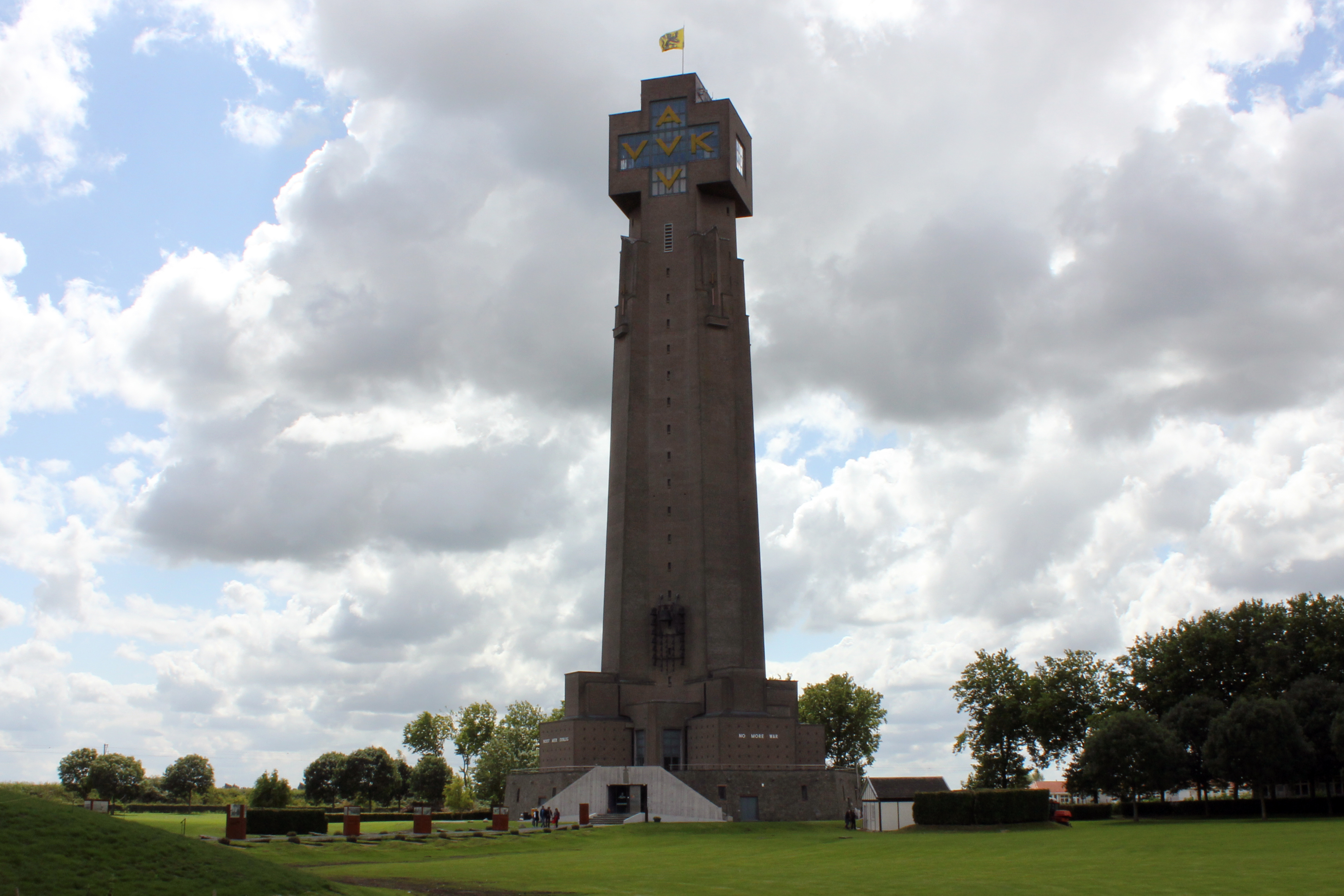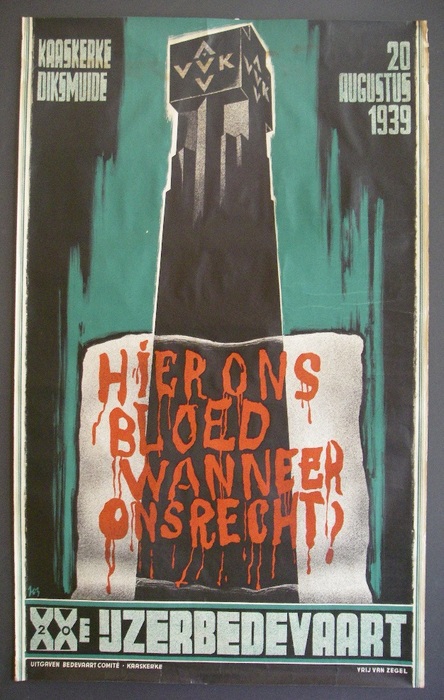Yser Tower on:
[Wikipedia]
[Google]
[Amazon]
 The Yser Towers () are a monument complex near the Yser river at
The Yser Towers () are a monument complex near the Yser river at
 The tower was finished in 1930 and incorporated the ''Frontbewegings
The tower was finished in 1930 and incorporated the ''Frontbewegings
 The Yser Towers () are a monument complex near the Yser river at
The Yser Towers () are a monument complex near the Yser river at Diksmuide
(; ; ) is a Belgian city and municipality in the Flemish province of West Flanders. The municipality comprises the city of proper and the former communes of Beerst, Esen, Kaaskerke, Keiem, Lampernisse, Leke, Nieuwkapelle, Oostkerke ...
, West Flanders
West Flanders is the westernmost province of the Flemish Region, in Belgium. It is the only coastal Belgian province, facing the North Sea to the northwest. It has land borders with the Dutch province of Zeeland to the northeast, the Flemis ...
in Belgium
Belgium, officially the Kingdom of Belgium, is a country in Northwestern Europe. Situated in a coastal lowland region known as the Low Countries, it is bordered by the Netherlands to the north, Germany to the east, Luxembourg to the southeas ...
. The first tower was built in 1928–30 to commemorate the Belgian soldiers killed on the surrounding Yser Front
The Yser Front (, or ), sometimes termed the West Flemish Front in British writing, was a section of the Western Front (World War I), Western Front during World War I held by Belgium, Belgian troops from October 1914 until 1918. The front ran alo ...
during World War I
World War I or the First World War (28 July 1914 – 11 November 1918), also known as the Great War, was a World war, global conflict between two coalitions: the Allies of World War I, Allies (or Entente) and the Central Powers. Fighting to ...
and as a monument to Christian pacifism
Christian pacifism is the Christian theology, theological and Christian ethics, ethical position according to which pacifism and non-violence have both a scriptural and rational basis for Christians, and affirms that any form of violence is inco ...
. It subsequently became an important political symbol for the Flemish Movement
The Flemish Movement (, ) is an umbrella term which encompasses various political groups in the Belgium, Belgian region of Flanders and, less commonly, in French Flanders. Ideologically, it encompasses groups which have sought to promote Flemis ...
and was destroyed in 1946 as a result of its association with Flemish nationalist collaboration in German-occupied Belgium in World War II
World War II or the Second World War (1 September 1939 – 2 September 1945) was a World war, global conflict between two coalitions: the Allies of World War II, Allies and the Axis powers. World War II by country, Nearly all of the wo ...
. The current tower was rebuilt alongside the remains of the original and copied its design. It was finished in 1965. It remains a site of political significance to Flemish nationalists and is the center for their annual Yser Pilgrimage (''IJzerbedevaart'').
Tower
First tower, 1930–1946
The idea for a distinct monument inFlanders
Flanders ( or ; ) is the Dutch language, Dutch-speaking northern portion of Belgium and one of the communities, regions and language areas of Belgium. However, there are several overlapping definitions, including ones related to culture, la ...
to commemorate the Flemish soldiers killed in the Belgian Army
The Land Component (, ), historically and commonly still referred to as the Belgian Army (, ), is the Land warfare, land branch of the Belgian Armed Forces. The King of the Belgians is the commander in chief. The current chief of staff of the Land ...
in World War I
World War I or the First World War (28 July 1914 – 11 November 1918), also known as the Great War, was a World war, global conflict between two coalitions: the Allies of World War I, Allies (or Entente) and the Central Powers. Fighting to ...
had been discussed since at least 1916 under the patronage of the priest Cyriel Verschaeve
Cyriel Verschaeve (30 April 1874 – 8 November 1949) was a Flemish nationalist priest and writer who collaborated with the Nazis during the Second World War. He was recognised as the spiritual leader of Flemish nationalism by the ideology's ad ...
. After some initial efforts, construction on a -high tower-shaped monument near the Yser river at Kaaskerke Kaaskerke is a town in Diksmuide, a part of Belgium.
See also
* West Flanders
West Flanders is the westernmost province of the Flemish Region, in Belgium. It is the only coastal Belgian province, facing the North Sea to the northwest. It has ...
near Diksmuide
(; ; ) is a Belgian city and municipality in the Flemish province of West Flanders. The municipality comprises the city of proper and the former communes of Beerst, Esen, Kaaskerke, Keiem, Lampernisse, Leke, Nieuwkapelle, Oostkerke ...
began in 1928. The site was symbolic because the Yser had represented the front-line of the Belgian Army for most of the war.
 The tower was finished in 1930 and incorporated the ''Frontbewegings
The tower was finished in 1930 and incorporated the ''Frontbewegings cruciform
A cruciform is a physical manifestation resembling a common cross or Christian cross. These include architectural shapes, biology, art, and design.
Cruciform architectural plan
Christian churches are commonly described as having a cruciform ...
motto "All for Flanders—Flanders for Christ" (''Alles Voor Vlaanderen, Vlaanderen Voor Kristus'', abbreviated to AVV—VVK) and was unveiled at the 11th annual Yser Pilgrimage (''IJzerbedevaart''). In following years, the human remains of a number of "Yser Symbols" (''IJzersymbolen'') were reburied in the crypt of the tower, including the Van Raemdonck brothers
Edward and Frans Van Raemdonck were two siblings killed while serving in the Belgian Army in World War I whose story subsequently became prominent within the popular memory of the conflict in post-war Flanders.
Born in Temse in East Flanders in ...
and Joe English. Initially associated with Christian pacifism
Christian pacifism is the Christian theology, theological and Christian ethics, ethical position according to which pacifism and non-violence have both a scriptural and rational basis for Christians, and affirms that any form of violence is inco ...
, the site soon became one of the most important symbolic political locations for the Flemish Movement and became associated with its largest contemporary political movements, notably the authoritarian Flemish National League
The (, "Flemish National Union" or "Flemish National League"), widely known by its acronym VNV, was a Flemish nationalist political party active in Belgium between 1933 and 1945.
(''Vlaamsch Nationaal Verbond'', VNV) and Union of Dutch National Solidarists (''Verbond van Dietsche Nationaal-Solidaristen'', Verdinaso).
The association of the Flemish Movement, especially the VNV, with collaborationism
Wartime collaboration is cooperation with the enemy against one's country of citizenship in wartime. As historian Gerhard Hirschfeld says, it "is as old as war and the occupation of foreign territory".
The term ''collaborator'' dates to the 19th c ...
during German occupation of Belgium during World War II
The German occupation of Belgium (, ) during World War II began on 28 May 1940, when the Belgian army surrendered to German forces, and lasted until Belgium's liberation by the Western Allies between September 1944 and February 1945. It was ...
led two former members of the Belgian Resistance
The Belgian Resistance (, ) collectively refers to the resistance movements opposed to the German occupation of Belgium during World War II, German occupation of Belgium during World War II. Within Belgium, resistance was fragmented between many ...
to illegally destroy the tower with dynamite
Dynamite is an explosive made of nitroglycerin, sorbents (such as powdered shells or clay), and Stabilizer (chemistry), stabilizers. It was invented by the Swedish people, Swedish chemist and engineer Alfred Nobel in Geesthacht, Northern German ...
on the night of 15–16 March 1946 as a reprisal. The ruins of the first tower were retained and were subsequently modeled into the Peace Gate (''Paxpoort'') in 1950.
Second tower, 1965–present
The second tower still stands at the site near to the remnants of the first. It was built to roughly the same design as the first but is larger at tall. The four sides of the base of the tower read "Never war again" in the three languages of Belgium, as well as in English. Work began in July 1952. The crypt was finished on 11 November 1958 and the tower itself was officially inaugurated on 22 August 1965. The tower houses the Yser Museum (''Museum aan de IJzer'') which belongs to theUnited Nations
The United Nations (UN) is the Earth, global intergovernmental organization established by the signing of the Charter of the United Nations, UN Charter on 26 June 1945 with the stated purpose of maintaining international peace and internationa ...
network of peace museum
The Peace Museum in Saltaire, West Yorkshire is the only museum in the UK dedicated to the history and stories of peace, peacemakers and the peace movement.
The initial idea of creating a peace museum arose in the mid-1980s from Gerald Drewett ...
s. The museum houses the large painting, ''The Golden Canvass of Flanders'' (''Het Gulden Doek van Vlaanderen'') by Dutch-born Belgian painter Henry Luyten
Henry Luyten or Jan Hendrik Luyten (21 May 1859 in Roermond – 21 January 1945 in Brasschaat) was a Netherlands, Dutch-born Belgium, Belgian painter. He is known for his Genre aer, genre scenes, marines, landscapes, portraits and animal sce ...
. The painting depicts a fictional meeting of the one hundred people who in Luyten's opinion played the most important roles in Flemish history. It is situated close to the preserved section of wartime trenches known as the " Trench of Death" (''Dodengang'').
See also
*Anton van Wilderode
Cyriel Paul Coupé (1918–1998) was a Belgian diocesan priest, teacher, writer and poet, also known by the pseudonym Anton van Wilderode.
Life
Coupé was born in Moerbeke-Waas on 28 June 1918. He was ordained as a priest on 21 May 1944 in the ...
* King Albert I Memorial
The King Albert I Memorial, also named the King Albert I Monument (; ) is a memorial at the Belgian coastal city of Nieuwpoort. It is located right outside the old town, on the right bank of the Yser river at the lock complex ''Ganzepoot''. T ...
(1938)
* List of World War I memorials and cemeteries in Flanders
Several war memorials and war graves have been erected in the Belgian region Flanders to memorialize the events that took place there during World War I. By the end of 1914 the Western Front ran from Nieuwpoort on the North Sea Coast to ...
* Monument to the Battle of the Nations
The Monument to the Battle of the Nations () is a monument in Leipzig, Germany, to the 1813 Battle of Leipzig, also known as the Battle of the Nations. Paid for mostly by donations and the city of Leipzig, it was completed in 1913 for the 100th a ...
(1913)
Further reading
*External links
{{Official website, http://www.ijzertoren.org/, IJzertoren official website Towers in Belgium Museums in West Flanders Diksmuide World War I memorials in Belgium 1946 in Belgium Buildings and structures completed in 1930 Buildings and structures completed in 1965 Buildings and structures demolished in 1946 Flemish Movement World War I museums in Belgium Funerary and memory sites of the First World War (Western Front)